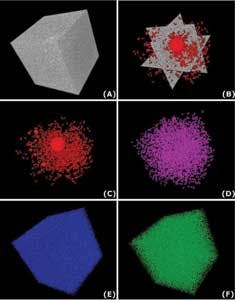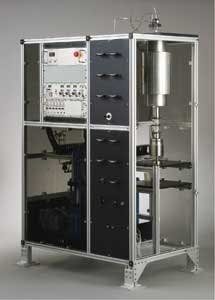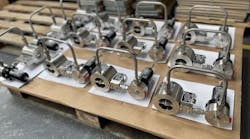Barbara Kutchko
National Energy Technology Laboratory
US Department of Energy
Following the Macondo incident, there was an increased focus on sustained casing pressure in the Gulf of Mexico within the offshore industry. As part of that response, the National Energy Technology Laboratory (NETL), the research arm of the US Department of Energy, has engaged in a program to investigate and develop technology to mitigate wellbore integrity issues related to cement failure, especially in deepwater. Research into the characteristics and failure mechanisms of foamed cement has been a primary element of this research program. State-of-the-art technologies are employed in the program.
NETL's multi-scale CT (X-ray computed tomography) imaging facility is equipped to investigate cement properties under in situ conditions that replicate downhole cement environments. This allows researchers to examine core samples under pressure, at temperature, and with fluid flow. CT scanning and other capabilities housed at the laboratory are helping researchers answer fundamental questions about how cement, casing, and subsurface formations interact downhole. Several of these capabilities are highlighted below.
(All images courtesy National Energy Technology Laboratory/US Dept. of Energy.)
Multi-scale CT scanning
To gain an unprecedented view of how foamed cement forms at elevated pressures typical in the subsurface, NETL uses industrial, medical, and micro CT scanners in conjunction with pressure vessels to study in situ cement conditions over a range of pressures and foam qualities. With these capabilities, NETL, and alliance partners Carnegie Mellon University, Pennsylvania State University, University of Pittsburgh, Virginia Polytechnic Institute and State University, and URS Corp., are examining this ubiquitous yet under-studied wellbore material to determine gas bubble stability as cement hardens.
Researchers also have used various software applications to derive statistical relationships related to (for example) foamed cement physical structure. The goal is to determine the conditions required for generating stable cement. In addition, injection properties, fluid-gas ratios, and additives are being examined to determine how they, too, affect stability. Because these experiments are non-destructive, difficult-to-obtain cement core samples are preserved for reuse. Digital images are also archived for future investigations.
Subsurface facilities
NETL's multi-functional subsurface experimental facilities were originally developed for investigations related to the underground injection of CO2 for carbon management, particularly with respect to reservoir storage, caprock sealing capacity, and wellbore cement integrity. NETL and alliance researchers are now using these facilities to conduct offshore and unconventional oil and gas wellbore investigations as well.
By exposing lab- and field-generated samples to downhole conditions, key data is collected on cement stability and performance in various chemical environments. The mechanical properties and behavior of various cement systems, including foamed cement, are being studied. For example, NETL's tri-axial core flow unit measures sonic velocity and resistivity to determine the dynamic behavior of foamed cement in situ.
NETL and partners are also using experimental results to build computer models of subsurface phenomena and processes that can increase the speed and lower the cost of ongoing investigations.
Analytical tools
The NETL laboratory houses a tri-axial multi-sensor core logger custom built to measure key geophysical properties like resistivity, gamma-density, and p-wave velocity. As a complement to NETL's CT scanning capabilities, the logger can provide high-resolution 2D graphs scanned down the length of a lab- or field-generated sample, providing data on a greater range of properties.
NETL also can analyze and characterize a variety of wellbore materials using petrography, environmental scanning electron microscopy with energy dispersive spectroscopy, x-ray and micro-x-ray diffraction, permeametry, thermogravimetric analysis, differential scanning calorimetry, and infrared and Raman spectroscopy. Analyses are used to characterize the fundamental properties of ultra-deepwater and frontier region reservoirs, unconventional natural gas and oil reservoirs, and reservoirs that offer potential for CO2 storage. Information gained helps NETL and its partners better understand field test sites, and it feeds computational models and simulations, risk assessments, and experimental studies investigations.
Research results
NETL researchers have produced the first high-resolution CT 3D images of two sets of atmospheric-generated foamed cement recipes across a range of foam qualities. CT imaging enabled the assessment and quantification of the foamed cement structure, quality, and bubble size distribution in order to provide a better understanding of foamed cement. Results are reported in NETL-TRS (Technical Report Series) -2-2013 "Computed Tomography and Statistical Analysis of Bubble Size Distributions in Atmospheric-Generated Foamed Cement," Kutchko et al., 2013; and NETL-TRS-2-2014 "Addendum 1 to Computed Tomography and Statistical Analysis of Bubble Size Distributions in Atmospheric-Generated Foamed Cement," Kutchko et al., 2014.
The testing of the physical properties of those same two foamed cement recipes (atmospheric-generated) has been completed. The physical properties include permeability, porosity, compressive strength, Young's modulus, and Poisson's ratio. The results indicate a clear correlation between the physical properties and the gas distribution of both sets of cements.
In addition, an upper/lower limit to foam quality that is guided by the mechanical/physical properties can be observed. For example, the foam quality (gas content) should not be too low because it will lack the mechanical benefits as shown by Young's modulus values. The foam quality also should not be too high as it still needs to provide zonal isolation. The results of this research are written in a TRS, which is undergoing review.
Currently, three major service companies have supplied NETL with field-generated foamed cement samples. These samples were collected using the same full-scale industrial equipment and methodology used to generate cement in a well. Using the methodology developed for the atmospheric-foamed cements, NETL researchers have produced the first X-ray CT, 3D images of field-generated foamed cement across a range of foam qualities and pressures.
CT scans and image analysis of atmospheric-generated foam cements (Kutchko et al., 2013) revealed bubble distributions that were larger (increasing with increased foam quality), more uniform in size, and more evenly distributed than that seen in field-generated foamed cements. The observed patterns indicate a high level of complexity of in situ foam cement behavior. The variations in cement structure within the pressurized foamed cement samples all appear to indicate a strong relationship between the flow of the cement slurry and the final porosity and properties of the in-place hardened cement. Work is continuing to isolate flow, distribution, and other relevant properties that can be engineered into safer and more efficient placement of foamed cement downhole.
Given the success of the atmospheric-generated foamed cement work, the next step is to apply this methodology to field-generated and pressure-generated foamed cements. A correlation between atmospheric-, field-, and pressure-generated foamed cement systems is important to improve understanding of the physical properties of foamed cement under wellbore conditions. This correlation will result in a better understanding of the effects that foam cement production, transport downhole, and delivery to the wellbore annulus have on the overall sealing process.








